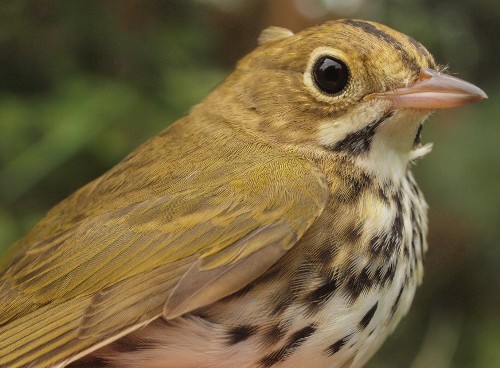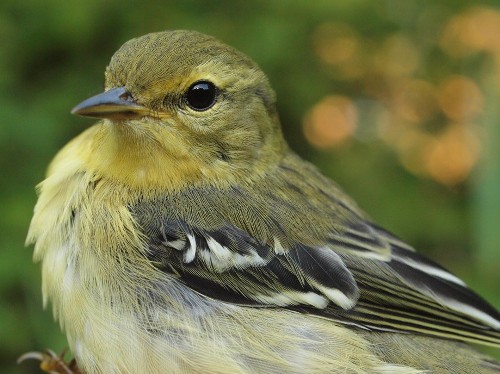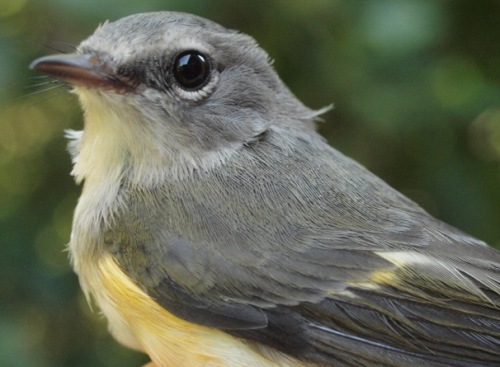|
Week 3: August 15-21, 2014 |
Welcome
to the McGill Bird Observatory weekly report.
Click here for a complete listing of our archives.
Comments or
questions are welcome at "mbo AT migrationresearch.org".
|
PICTURE
OF THE WEEK: |
|

Ovenbirds were among the more common warblers at MBO this week.
(Photo by Simon Duval)
-
|
|
|
THIS WEEK |
THIS FALL |
2014 TOTAL |
SITE TOTAL |
|
# birds (and species) banded |
121 (32) |
514 (49) |
2013 (77) |
48323 (113) |
|
# birds (and species) repeat |
44 (21) |
135 (32) |
474 (48) |
9608 (70) |
|
# birds (and species) return |
6 (6) |
22 (11) |
162 (29) |
1596 (38) |
|
# species observed |
88 |
105 |
147 |
209 |
|
# net hours |
444.0 |
1464.0 |
4877.4 |
84060.7 |
|
# birds banded / 100 net hours |
27.3 |
35.1 |
41.3 |
57.5 |
|
|
Note: table does not include nocturnal banding (owls) |
|
Banders-in-charge: Simon Duval and Gay Gruner
Assistants: Angelika Aleksieva,
Johannie Bernard, Nicolas Bernier, Sue Bishop, Marc Boisvert, Cindy Bouchard, Marie-France Boudreault, David Davey, Jean Demers, Geneviève Dubois, Lauriane Dubuc, Barbara Frei, Alison Hackney, Lisa Keelty, Helen Kohler, Lance Laviolette, Agathe Lebeau, Marcel Lebeau, Barbara MacDuff, Raymon Michaud, Ana Morales, Raymonde Palardy, Benoît Piquette, Catherine Russell, Ahmad Shah, Carollynne Smith, Clémence Soulard, Rodger Titman, Christiane Tremblay
Notes:
We have come to know that week 3 is typically the quietest of our 13 weeks of fall migration. Even so, it was particularly slow this week, with the 132 birds banded the second-fewest ever for this period. Once again though, observers were rewarded with a rich variety of birds – the 88 species observed is the second-highest total ever for week 3 (only behind last year’s incredible count of 95), and similarly the cumulative total of 105 for the season is ahead of the pace for all previous years except for 2013.

Blackpoll Warbler usually peaks at MBO in September, but some individuals are already moving through.
(Photo by Simon Duval)
|
The only new species observed for the year this week was Common Nighthawk; among the birds banded, none were new for 2014, but we did have our first Blackpoll Warbler of the fall
.
This week’s top 10 [last week's rank in brackets]
# individuals banded |
mean # individuals observed daily |
1. American Redstart (13) [1] |
1. Common Grackle (36) [3] |
2. Tennessee Warbler (9) [5] |
2. American Robin (28) [1] |
2. Magnolia Warbler (9) [-] |
3. American Goldfinch (19) [4] |
4. Ovenbird (8) [-] |
4. Tree Swallow (17) [-] |
4. Song Sparrow (8) [2] |
5. American Crow (17) [-] |
6. American Robin (7) [4] |
6. Cedar Waxwing (15) [2] |
6. Gray Catbird (7) [3] |
7. Red-winged Blackbird (14) [10] |
8. Red-eyed Vireo (6) [5] |
8. Black-capped Chickadee (13) [5] |
8. Northern Waterthrush (6) [-] |
9. Blue Jay (11) [6] |
8. Common Yellowthroat (6) [5]
|
10. Broad-winged Hawk (11) [-] |
|
Despite the overall drop in number of birds banded this week, American Redstart managed to hold on to first place for the third straight week – a spot it has occupied for week 3 in five of the last seven years. It was certainly a week of warblers, with five other species in the top ten as well, including two holdovers from last week (Tennessee Warbler and Common Yellowthroat), and three new additions (Ovenbird, Northern Waterthrush, and Magnolia Warbler). Again American Robin hovered around the middle of the pack, although Black-capped Chickadees have dropped out of the top ten (we are still catching this year’s juveniles – it’s just that by now they are being classified as repeats, rather than new birds banded.
The mean daily count of American Robins has remained steady in the twenties, but this week Common Grackle was a bit more numerous. While Common Grackle has typically not been very numerous at this point in fall, it did dominate week 3 once previously in 2012 (and by a much more significant margin, with a mean daily count of 186 in that case!). Most notable among this week’s three newcomers in the top ten was Tree Swallow, which has only shown up on the list for week 3 once previously, with a mean daily count of 11 individuals in 2007. Given that swallow numbers have been in steady decline for the past several years, this was a pleasant surprise. Perhaps even more surprising though was the large movement of Broad-winged Hawks, given that their migration usually peaks sharply around a mid-September peak – and over our first five years of fall migration monitoring, we counted only a grand total of six individuals during week 3!
|

American Redstarts dominated the week at MBO, including this after-hatch-year female.
(Photo by
Simon Duval)
|



